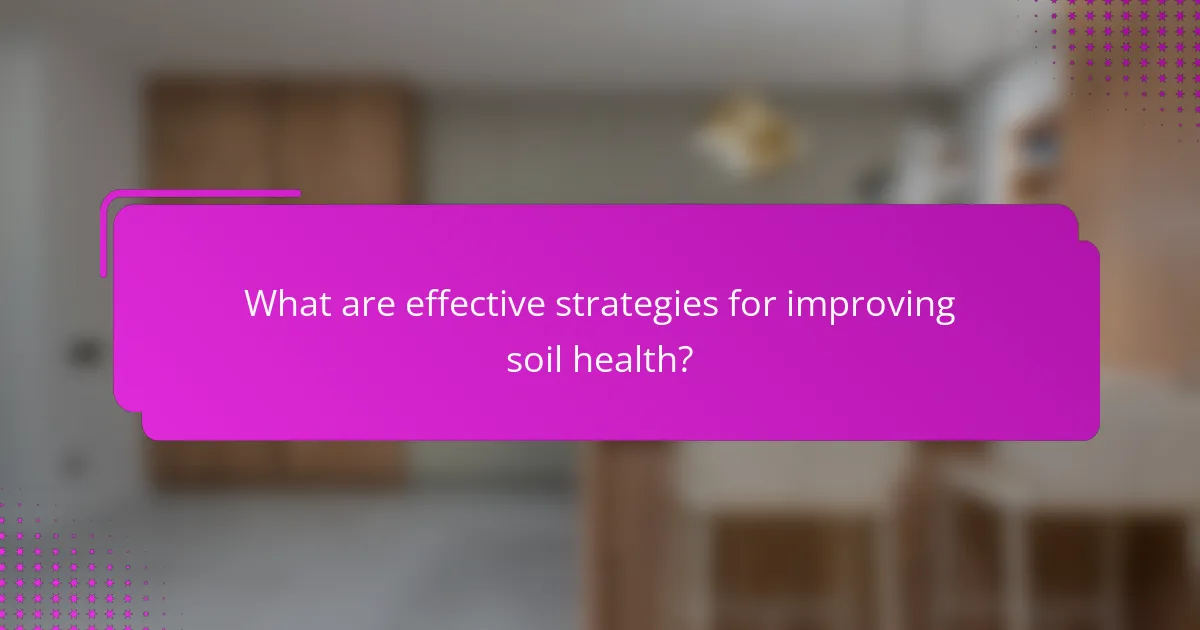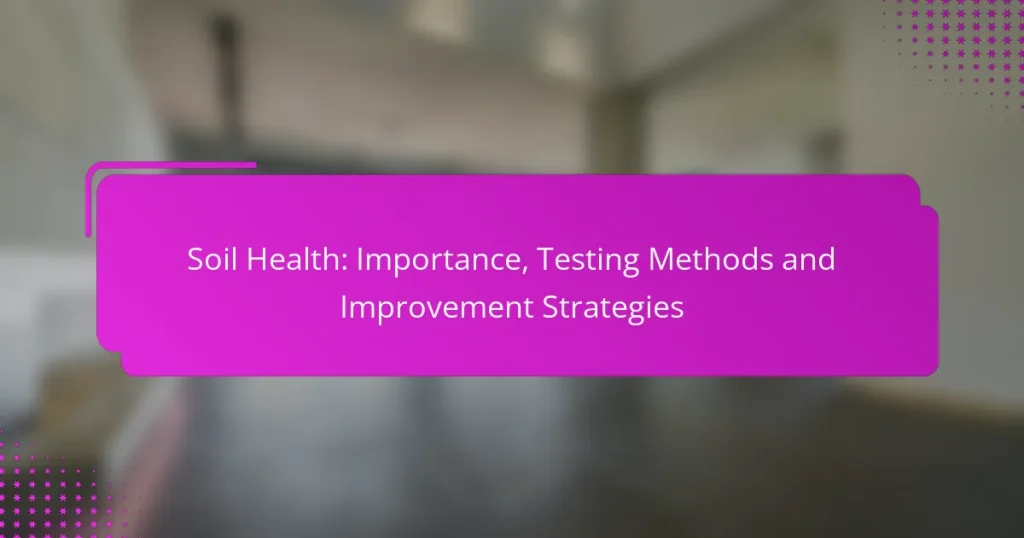Soil health is essential for sustainable agriculture and environmental stability, significantly impacting productivity and ecosystem resilience. By assessing its physical, chemical, and biological properties through various testing methods, farmers can identify ways to enhance soil quality and implement effective strategies that promote biodiversity and improve crop yields.

What are the benefits of soil health?
Soil health is crucial for sustainable agriculture and environmental stability, offering numerous benefits that enhance productivity and ecosystem resilience. Healthy soil improves crop yields, supports biodiversity, retains water, reduces erosion, and increases carbon sequestration, all of which contribute to a more sustainable agricultural system.
Improved crop yields
Healthy soil provides essential nutrients, promotes root development, and enhances microbial activity, all of which lead to improved crop yields. Farmers can expect higher productivity when soil is rich in organic matter and well-structured, often resulting in yields that are significantly better than those from depleted soils.
To maximize yields, regular soil testing is recommended to determine nutrient levels and pH balance. Implementing crop rotation and cover cropping can also enhance soil fertility and structure, leading to sustained yield improvements over time.
Enhanced biodiversity
Soil health fosters a diverse ecosystem of microorganisms, fungi, and insects, which play vital roles in nutrient cycling and disease suppression. Biodiverse soils are more resilient to pests and diseases, reducing the need for chemical inputs and promoting a healthier environment.
Practices such as reduced tillage and organic amendments can help maintain and enhance soil biodiversity. Encouraging natural habitats around agricultural fields can also support beneficial organisms that contribute to soil health.
Better water retention
Healthy soils have improved structure and organic matter content, which enhances their ability to retain water. This is particularly beneficial in regions prone to drought, as it allows crops to access moisture more effectively, reducing irrigation needs.
To improve water retention, consider incorporating organic materials like compost or mulch into the soil. These amendments can increase soil porosity and help maintain moisture levels, leading to more resilient agricultural practices.
Reduced erosion
Soil health plays a critical role in minimizing erosion, which can lead to the loss of fertile topsoil and degradation of land. Healthy soils with good structure and vegetation cover are less susceptible to erosion from wind and water.
Implementing practices such as contour farming, cover cropping, and maintaining ground cover can significantly reduce erosion risks. These strategies help stabilize soil and protect it from the forces that cause erosion.
Increased carbon sequestration
Healthy soils can sequester carbon, helping to mitigate climate change by storing carbon dioxide from the atmosphere. Practices that enhance soil health, such as agroforestry and organic farming, promote carbon storage in the soil.
To increase carbon sequestration, focus on building soil organic matter through composting, reduced tillage, and planting cover crops. These methods not only improve soil health but also contribute to climate change mitigation efforts.

How can soil health be tested in the United States?
Soil health in the United States can be tested through various methods that assess its physical, chemical, and biological properties. These tests help determine nutrient levels, pH balance, and microbial activity, guiding farmers and land managers in improving soil quality.
Soil pH testing
Soil pH testing measures the acidity or alkalinity of the soil, which affects nutrient availability and microbial activity. A pH range of 6.0 to 7.5 is generally considered optimal for most crops in the U.S.
To test soil pH, collect samples from different areas of your field and mix them. Use a pH meter or pH test kit, following the manufacturer’s instructions for accurate results. Adjustments can be made using lime to raise pH or sulfur to lower it.
Nutrient analysis
Nutrient analysis evaluates the levels of essential nutrients like nitrogen, phosphorus, and potassium in the soil. This information is crucial for determining fertilizer needs and ensuring optimal plant growth.
Samples should be sent to a certified laboratory for analysis, where they will provide a detailed report on nutrient concentrations. Regular testing, ideally every few years, helps track changes and informs management practices.
Microbial activity assessment
Microbial activity assessment measures the biological health of the soil, indicating its ability to support plant life and nutrient cycling. Healthy soils typically have a diverse microbial community that enhances soil structure and fertility.
Methods such as soil respiration tests or enzyme activity assays can be used to assess microbial health. Monitoring microbial activity can help identify soil management practices that promote biodiversity and resilience.
Soil texture analysis
Soil texture analysis determines the proportions of sand, silt, and clay in the soil, which influences water retention, drainage, and nutrient availability. Understanding soil texture helps in selecting appropriate crops and management practices.
To analyze soil texture, you can use the jar test, where soil is mixed with water and allowed to settle. The layers formed indicate the texture. Knowing your soil texture can guide irrigation and tillage practices to improve soil health.

What are effective strategies for improving soil health?
Effective strategies for improving soil health include practices that enhance soil structure, increase organic matter, and promote biodiversity. Implementing these strategies can lead to better crop yields, reduced erosion, and improved water retention.
Cover cropping
Cover cropping involves planting specific crops during off-seasons to protect and enrich the soil. These crops, such as clover or rye, can prevent erosion, suppress weeds, and enhance soil fertility by fixing nitrogen and adding organic matter when they decompose.
When selecting cover crops, consider local climate and soil types. Aim for a mix of deep-rooted and shallow-rooted species to maximize soil benefits. Timing is crucial; plant cover crops early enough to establish before winter and terminate them before planting cash crops.
Crop rotation
Crop rotation is the practice of alternating different crops in the same field across seasons. This strategy helps disrupt pest and disease cycles, improves soil nutrient balance, and enhances biodiversity.
For effective crop rotation, plan a sequence that includes legumes, which can fix nitrogen, followed by nutrient-demanding crops like corn. A typical rotation might involve planting legumes one year, followed by a cereal crop the next, and then a root vegetable.
Organic amendments
Organic amendments, such as compost, manure, or green waste, are materials added to soil to improve its structure and nutrient content. These amendments enhance microbial activity and increase organic matter, leading to healthier soil ecosystems.
When applying organic amendments, aim for a balanced approach. Generally, adding 2-5 tons of compost per acre annually can significantly boost soil health. Ensure that the amendments are well-aged to avoid introducing pathogens or weed seeds.
No-till farming
No-till farming minimizes soil disturbance by planting crops directly into undisturbed soil. This practice helps maintain soil structure, reduces erosion, and enhances moisture retention, leading to healthier soil ecosystems.
To implement no-till farming, use specialized equipment designed for direct seeding. Monitor soil health regularly, as this method may require adjustments in nutrient management to compensate for reduced soil disturbance. Consider integrating cover crops to further enhance soil quality in a no-till system.

What criteria should be considered for soil health improvement?
Improving soil health involves evaluating several key criteria, including soil type, climate conditions, and crop selection. Each of these factors plays a crucial role in determining the best practices for enhancing soil quality and fertility.
Soil type
The soil type significantly influences its health and productivity. Different types of soil, such as sandy, clay, or loamy, have distinct properties affecting water retention, nutrient availability, and aeration. For instance, loamy soils are often considered ideal due to their balanced texture and fertility.
When assessing soil type, consider conducting a soil texture test to determine the proportions of sand, silt, and clay. This information can guide decisions on amendments and management practices tailored to the specific soil characteristics.
Climate conditions
Climate conditions, including temperature, rainfall, and humidity, directly impact soil health. Regions with consistent rainfall may require different management strategies compared to arid areas where water conservation is crucial. Understanding local climate patterns helps in selecting appropriate crops and soil amendments.
For example, in humid climates, organic matter decomposition occurs rapidly, necessitating regular additions of compost or mulch to maintain soil fertility. Conversely, in drier climates, practices like cover cropping can help retain moisture and prevent erosion.
Crop selection
Choosing the right crops is essential for improving soil health. Different crops contribute various nutrients to the soil and can enhance its structure. Leguminous plants, for instance, fix nitrogen, enriching the soil for subsequent crops.
Consider implementing crop rotation strategies to prevent nutrient depletion and manage pests. Diversifying crop selection not only boosts soil health but also increases resilience against climate variability and disease outbreaks.


